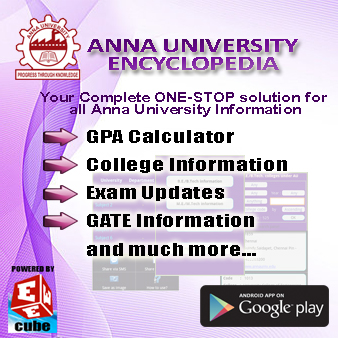SUBJECT RESOURCES:
CLICK HERE to access 'Question Bank'
CLICK HERE to access 'Previous Year Question Papers'
CLICK HERE to access '2 Marks'
CLICK HERE to access 'Notes'
CLICK HERE to search more about this subject
SYLLABUS:
CLICK HERE to access 'Question Bank'
CLICK HERE to access 'Previous Year Question Papers'
CLICK HERE to access '2 Marks'
CLICK HERE to access 'Notes'
CLICK HERE to search more about this subject
SYLLABUS:
EE 2302 ELECTRICAL MACHINES -
II L T P C
3 1 0 4
AIM
To expose the students to the concepts of synchronous and asynchronous machines and analyze their performance.
OBJECTIVES
To
impart knowledge on
i. Construction and performance of salient and non – salient type synchronous generators. ii. Principle of operation and performance of synchronous motor.
iii. Construction, principle of operation and performance of induction machines.
iv. Starting and speed control of three-phase induction motors.
v. Construction, principle of operation and performance of single phase induction motors and special
machines.
UNIT I SYNCHRONOUS GENERATOR 9
Constructional details – Types of rotors – emf equation – Synchronous reactance – Armature
reaction – Voltage regulation – EMF, MMF, ZPF and A.S.A methods – Synchronizing and parallel
operation – Synchronizing torque - Change of excitation and mechanical input – Two reaction theory
– Determination of direct and quadrature axis synchronous reactance using slip test – Operating characteristics - Capability curves.
UNIT II SYNCHRONOUS MOTOR 8
Principle of operation – Torque equation – Operation on infinite bus bars - V-curves
– Power input
and power
developed equations – Starting methods – Current loci for
constant power input, constant excitation and constant power developed.
UNIT III THREE PHASE INDUCTION
MOTOR 12
Constructional details – Types of rotors – Principle of operation – Slip – Equivalent circuit – Slip-
torque characteristics - Condition for maximum torque – Losses and efficiency – Load test - No load and blocked rotor tests - Circle diagram – Separation of no load losses
– Double cage rotors –
Induction generator – Synchronous induction motor.
UNIT IV STARTING AND SPEED CONTROL OF THREE PHASE INDUCTION
MOTOR 7
Need for starting – Types of starters – Rotor resistance, Autotransformer and Star-delta starters – Speed control – Change of voltage, torque, number of poles and slip – Cascaded connection – Slip
power recovery scheme.
UNIT V SINGLE PHASE INDUCTION MOTORS AND SPECIAL MACHINES 9
Constructional details of single phase induction motor – Double revolving field theory and operation
– Equivalent circuit
– No load and blocked rotor test – Performance analysis – Starting methods of
single-phase induction motors - Shaded pole induction motor -
Linear reluctance motor -
Repulsion motor - Hysteresis motor
- AC
series motor.
L = 45 T = 15 TOTAL = 60 PERIODS
TEXT BOOKS
1. D.P. Kothari and I.J. Nagrath, ‘Electric Machines’, Tata McGraw Hill Publishing
Company Ltd 2002.
2. P.S. Bhimbhra, ‘Electrical
Machinery’, Khanna Publishers, 2003.
REFERENCES
1. A.E. Fitzgerald, Charles Kingsley, Stephen.D.Umans, ‘Electric Machinery’, Tata
McGraw Hill publishing Company Ltd, 2003.
2. J.B. Gupta, ‘Theory and Performance of Electrical
Machines’, S.K.Kataria and Sons, 2002.
3. K. Murugesh Kumar, ‘Electric Machines’, Vikas Publishing House Pvt Ltd, 2002.
|
|










No comments:
Post a Comment
Note: Only a member of this blog may post a comment.